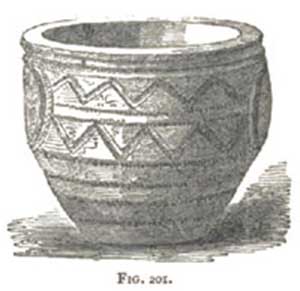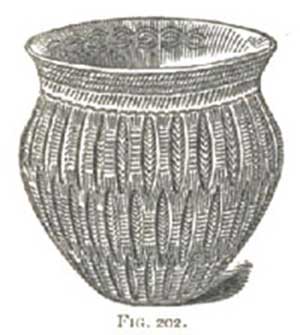Modes of Burial in Ancient Ireland
From A Smaller Social History of Ancient Ireland 1906
« previous page | contents | start of chapter | next page »
CHAPTER XXVII....continued
3. Modes of Burial.
In ancient Ireland the dead were buried in a variety of ways. One mode was to place the body lying flat in the grave as at present, usually with the feet to the east; and another was to put it standing up, fully armed, as described below. Occasionally it was placed in a sitting posture. Still another mode was to burn the body, and deposit the ashes and fragments of bones in an ornamented urn, generally of baked clay, but sometimes of stone.
FIG. 201. Cinerary Urn, of stone, a very rare and beautiful specimen: 8¾ in. high; now in National Museum. (From Wilde's Catalogue.)
All four prevailed in pagan times: but the first only was sanctioned and continued by Christianity. Of the first two modes of interment—lying flat and standing up—we have ample historical record. But as to the last—cremation—I can find in the whole range of Irish literature only one direct allusion to it, and even that not in the native Irish writings. Yet we know that cremation was extensively practised in pagan Ireland; for urns containing ashes and burnt bones are found in graves in every part of the country.
FIG. 202. Cinerary Urn, of baked clay: 6 ½ in. high: now in the National Museum. (From Wilde's Catalogue).
Cremation and ordinary burial were practised contemporaneously, as we know from the well-ascertained fact, that in the same cromlech or grave complete skeletons have been found along with urns containing ashes and burnt bones. This is what we should expect; for cremation was a troublesome and expensive process, and could not have been practised by poor people, most of whom must have buried the body without burning.
Occasionally the bodies of kings and chieftains were buried in a standing posture, arrayed in full battle costume, with the face turned towards the territories of their enemies. Of this custom we have several very curious historical records. In the Book of the Dun Cow it is related that King Laegaire [Laery] was killed "by the sun and wind" in a war against the Lagenians; and "his body was afterwards brought from the south, and interred, with his arms of valour, in the south-east of the external rampart of the royal Rath Laegaire at Temur (Tara), with the face turned southwards upon the Lagenians [as it were] fighting with them, for he was the enemy of the Lagenians in his lifetime." The battle of Culliu was fought on a spot which was subsequently overflowed by Lough Corrib, where Mannanan mac Lir fell: and the Dinnsenchus says:—"He was killed in that battle and buried standing up in that place."
The truthfulness of these records is borne out by the actual discovery of skeletons standing up in graves. In 1848 a tumulus called Croghan Erin in the County Meath was opened, and a skeleton was found under it standing up. About the year 1884, a skeleton was found standing erect in a carn near Belmullet, County Mayo.
The pagan Irish believed that while the body of their king remained in this position, it exercised a malign influence on their enemies, who were thereby always defeated in battle—a superstition that also prevailed among the ancient Britons.*
« previous page | contents | start of chapter | next page »
NOTE
* For much more on this point, see my Irish Names of Places, vol. I., p. 330: and the larger Social History, II., 552.


